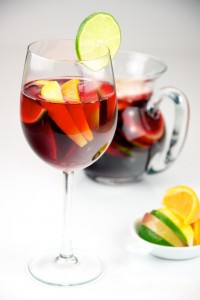
No doubt you have tried this fruity drink once in your lifetime. I make it at home and for parties often and I hear people refer to it as ‘fruit punch’. Although it does contain fruit, it is far from a punch given the high alcohol content. Sangría contains 4%-12% alcohol so it isn’t a big surprise to me when I have 20 cars parked outside my house the morning after my party because I won’t let some of my guests drive home. My guests never believe me when I tell them that sangria will sneak up on you.
So, what is the origin of this Spanish cocktail? Well, we can thank the Romans who found their way to the Iberian Peninsula and planted vineyards. Back when water was unsafe to drink people would add alcohol to their water to get rid of any bacteria. Naturally, they also added spices and herbs to boost the flavor of the drink. And that is how sangría was born; the Spanish interpretation of drinkable water.
Most sangrías are made out of red wine but in Spain they are also made out of white wine, cava, and even cider. But, there is no “right way” to make sangría. I will share my recipe with you, but I offer a bit of caution- it will punch you if you drink too much.
Michael’s Sangría: 
1.5 bottles of cheap red wine (don’t bother to waste your money since the fruit will hide the taste of the better wine)
2 TBSP sugar
1 lemon (sliced)
1 orange (sliced)
1 apricot (sliced)
1 oz. of Spanish brandy
1 oz. of sweet vermouth
1 oz. Bacardi
2 cups Fanta Orange
2 cups 7 Up
Instructions:
-Pour your wine into a container
-Add all of your fruit to the container and let it sit for five hours
-Add the remaining liquids and ice
Michael’s Tips:
- Some people add a spoon of cinnamon. I have been told by many restaurants in Spain that cinnamon mixed with alcohol can lead to a horrible hangover. I haven’t taken the time to test this out yet.
- The white part of the orange and lemon are bitter so you can either remove it or add a little more sugar to fight the bitterness.
- Some fruit oxidizes fast—like apricots. Out the container in the refrigerator to slow down the oxidization.
To learn more about Sangría or complain about the accuracy of this article, please contact the author.
Follow us in Social Media:
Twitter: @localconcept1
Google+: https://plus.google.com/+LocalConceptUS
LinkedIn: https://www.linkedin.com/in/localconcept/
Facebook: https://www.facebook.com/Local.Concept.Inc/


